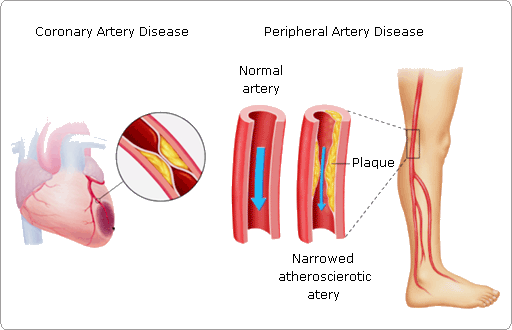Throughout the world the prevalence of diabetes is widespread, with the rates of diagnosis rapidly increasing. In Australia foot related issues are the leading cause of hospitalisations in patients with diabetes and our amputation rate is one of the worst in the western world. Given these facts it is important to understand the effects of diabetes on our feet. The contributing factors are almost as widespread as the diseases prevalence however the two greatest causes are familial histories and lifestyle factors (diet, exercise and stress). The main concerns we come across clinically in patients with diabetes are issues affecting circulation and the nerves. These systems are so important in our bodies because dysfunction in either or both can lead to serious complications which will be discussed further.
Peripheral Vascular Disease Peripheral vascular disease (PVD) is a condition that causes the blockage, hardening or narrowing of the arteries in our legs and therefore can decrease the amount of blood supplied to the feet. Deprivation of sufficient blood can lead to a reduction in healing rates, which then increases the risk of infection and ischaemia (complete loss of blood to one area) which then leads to other complications such as gangrene.

Symptoms of peripheral vascular disease include:

• Claudication: leg pain which mainly affects the calf muscles particularly when walking or exercising and disappears after a few minutes of rest • Rest Pain: pain in the legs without physical exertion caused by the muscles being starved of vital nutrients brought by blood • Numbness, tingling, or coldness in the lower legs or feet and visual signs of pale skin with a loss of hair and reduced rates of nail growth
At Step Forward Podiatry we have the ability to test your arterial supply with our state of the art doppler ultrasound machine. This uses sound waves to assess the health of the arteries in your feet and ensures adequate blood supply is present to allow for healing.
Peripheral Neuropathy
Peripheral neuropathy is a condition affecting the nerves in our body. The condition causes a deterioration of the outer lining of the nerves and causes a loss of connection between the brain and our feet. With this loss of connection the chances of injuries, cuts, scratches and abrasions can easily go unnoticed and with this comes a high risk of infection and further injury.
Symptoms of peripheral neuropathy in our feet include:
• Gradual onset of numbness and tingling in your feet or hands
• This may begin at your toes and spread upwards towards the legs
• Higher than usual sensitivity to touch
• Sharp or burning pain
• A feeling of being unbalanced and excessive falling
• Muscle weakness and a feeling of fatigue
At Step Forward Podiatry we have a range of tests including monofilament and vibration perception tools to check if your protective sensation is intact. Protective sensation is the conscious ability to know if something is abnormal in your feet from which we can then “protect” ourselves from further harm (eg a broken toe, an infection or a lesion).

The importance of regular monitoring for both peripheral vascular disease and peripheral neuropathy is essential, as both can have negative repercussions on our feet and therefore our overall lifestyles and health. The way to reduce any risk of developing either of these conditions is quite simple. It all comes down to adequate diabetes management- put simply- if the diabetes is being managed well by regulating blood glucose levels between healthy ranges, there is no reason to think even after being diagnosed with diabetes you will develop any of these foot complaints.
The SF Podiatry team prides itself on the ability to identify risk factors and early detection of either of these conditions and always works hard to educate patients based on their individual circumstances.
A little bit of knowledge can go a long way to reducing your risk of future pedal complications.

